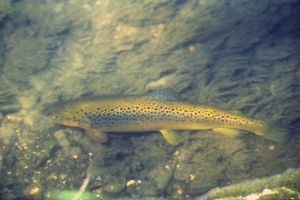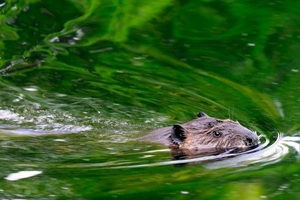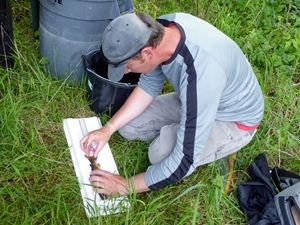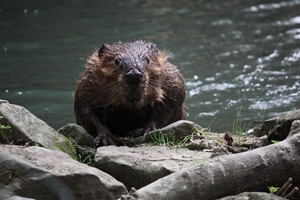Key points
- Rivers are important habitats for lots of species, and beavers are viewed as a natural way to restore rivers to good condition.
- This study aimed to understand the impacts of beavers and their dams on brown trout in a stream in Inverness-shire, comparing it with a nearby stream without beavers.
- From 2014 to 2016 brown trout were studied in the two streams and environmental data were recorded.
- The findings of this study suggest that habitat modifications made by beavers can be greatly positive for multiple life stages of brown trout, but the impact on juvenile trout and trout populations needs to be considered.
- Many of the findings compared with research from the USA and across Europe.
- More research is needed to understand the impact of beaver dams on trout migration and to study the impact of beavers on a larger scale and for different species.
Background
 Brown trout are part of the Salmonidae family of fish. They are widely found in freshwater habitats such as rivers, streams, lakes and canals across the UK. In many British rivers, some brown trout migrate to the sea in the spring when they are 2-3 years old, to look for food and grow. Once mature, they return to the rivers they were born in as ‘sea trout’ in late spring to summer, ready to spawn in the autumn.
Brown trout are part of the Salmonidae family of fish. They are widely found in freshwater habitats such as rivers, streams, lakes and canals across the UK. In many British rivers, some brown trout migrate to the sea in the spring when they are 2-3 years old, to look for food and grow. Once mature, they return to the rivers they were born in as ‘sea trout’ in late spring to summer, ready to spawn in the autumn.
Brown trout are a medium to large predatory fish that mainly feed on small fish when at sea, and insect larvae and flying insects such as mayflies and damselflies when in rivers. They typically live for 5-6 years (but occasionally up to 15-20 years) and they spawn between January and March in shallow gravelly riverbeds. They are priority species under the UK Post-2010 Biodiversity Framework but still face threats such as water pollution, climate change, declining food sources, and physical barriers such as hydroelectric dams and weirs.
In the UK, freshwater corridors such as rivers have been altered and modified by humans for centuries. Rivers and streams have been straightened, channelised and constrained for agriculture, domestic and industrial water supply, energy generation, and flood defence purposes. This has disrupted both natural river processes and the wildlife that inhabit these areas. Freshwater habitats are globally threatened and so there is a need to restore rivers, but this is very expensive, costing from around £2 million to around £26 million per km2.
Reintroducing beavers is viewed as a natural method, or ‘Nature Based Solution’, to this problem, offering a low-cost, self-sustaining method of restoring rivers. Beavers are considered ecosystem engineers as they modify both aquatic and riverside habitats. They increase the complexity of waterways and allow rivers and streams to function naturally by:
- Regulating water flow
- Storing sediment
- Reducing woodland density around waterways
- Improving habitat diversity
- Changing the amount of slow and fast flowing water in rivers
 Beavers build dams in waterways and create ponds that have a layer of silt at the bottom. This can offer suitable habitat for small fish such as minnows, sticklebacks and lamprey as well as larger fish like mature trout to feed, rest, overwinter and shelter. However, there are concerns that beaver dams may interfere with the upstream migration of spawning Atlantic salmon, sea trout and brown trout; and the downstream migration of juvenile fish heading to sea. Most studies on beavers have been done in North America or in mainland Europe, so it is difficult to know how they will impact fish in a UK context.
Beavers build dams in waterways and create ponds that have a layer of silt at the bottom. This can offer suitable habitat for small fish such as minnows, sticklebacks and lamprey as well as larger fish like mature trout to feed, rest, overwinter and shelter. However, there are concerns that beaver dams may interfere with the upstream migration of spawning Atlantic salmon, sea trout and brown trout; and the downstream migration of juvenile fish heading to sea. Most studies on beavers have been done in North America or in mainland Europe, so it is difficult to know how they will impact fish in a UK context.
A breeding pair of beavers were introduced into a 40-hectare enclosure in 2008 on the Allt Coire an t-Seilich stream, which feeds into Loch Grant. A nearby stream, Allt a’ Choilich, does not have beavers present but feeds into the same loch, meaning it could be used as a useful ‘control’ comparison. This pair of streams in Inverness-shire were in similar condition before the beavers were introduced, which allowed this study to investigate the impact of beavers on trout.
What they did
 The scientists studied multiple age-classes of brown trout in the two streams between 2014 and 2016 to see how the fish responded to river modifications made by the beavers, compared to how they behaved in the stream without beavers. This included juvenile fish (less than one year old), one-year-old sub-adult, and adult fish. The scientists collected data on the water depth, water temperature and habitat characteristics of the two streams as well as factors relating to the fish, including:
The scientists studied multiple age-classes of brown trout in the two streams between 2014 and 2016 to see how the fish responded to river modifications made by the beavers, compared to how they behaved in the stream without beavers. This included juvenile fish (less than one year old), one-year-old sub-adult, and adult fish. The scientists collected data on the water depth, water temperature and habitat characteristics of the two streams as well as factors relating to the fish, including:
- Trout abundance
- Trout density
- Fish size
- Fish growth
- Invertebrate richness
What they found
Across three years of surveying, the scientists found that the beaver-modified stream was better than the unmodified stream for larger trout, which are known to prefer deeper pools. Both streams saw abundance and density of fish increase in the autumn. This is likely to be because of the creation of numerous pools by the beaver dams that were deeper, wider and slower-flowing than in the mostly shallow unmodified stream.
Trout abundance across all age groups was highest in the beaver-modified stream, being 5.8 times higher than the unmodified stream in 2015, and 2.5 times higher in 2016. There was no statistical difference in abundance (of all ages) between the two streams in 2014. Sub-adult fish were most abundant in the beaver-modified stream, with higher levels also observed in the autumn.
There was no difference in trout density between the two streams in 2014 for any age groups. In 2015 and 2016, however, the unmodified stream had a density that was 3 times and 10 times higher respectively.
In terms of fish size, a greater variety of fish lengths were observed in the beaver-modified stream throughout the study period, across all seasons. Fish were characteristically both longer and heavier in the beaver-modified stream.
Growth performance, measured in terms of length and fish mass, showed a strong positive trend in the beaver-modified stream. The rate varied with season, with the highest growth rates observed in spring and the lowest rates observed in winter.
The beaver modified stream also had the highest abundance of invertebrates. Of all the invertebrates sampled, there were six groups strongly associated with the beaver-modified stream.
What does this mean?
 The stream modifications made by the beavers, such as the creation of deeper, slower-flowing pools, improved the complexity of the stream and provided deeper water and structure in which fish could hide from predators, shelter, rest and forage for food. These modifications also made the temperature of these habitats more consistent.
The stream modifications made by the beavers, such as the creation of deeper, slower-flowing pools, improved the complexity of the stream and provided deeper water and structure in which fish could hide from predators, shelter, rest and forage for food. These modifications also made the temperature of these habitats more consistent.
Previous research has found that invertebrate groups such as fly and midge larvae are frequently consumed by brown trout, and this study found some of these were strongly associated with beaver-modified habitat. This suggests that beaver dams can support a high number of prey resources for brown trout.
As a result, both sub-adult and adult trout were more abundant, larger in size, and had more food availability in the beaver-modified stream. They also showed a wider range of size classes and had a higher growth rate through the year, which was even higher for some individuals in winter than the greatest predicted growth.
The beaver-modified habitat was able to support multiple life stages and could maintain large numbers of older trout. Trout in the beaver-modified stream were also characteristically longer than fish from the unmodified stream, an observation also made through research in the USA and Europe.
Despite these higher numbers of fish, no difference in trout density was observed between the two streams because beaver modifications increased surface area of the stream, thus allowing the fish to spread out and reducing overall fish density. This also reduced competition between individual fish. These findings suggest that beaver modifications to streams can improve the individual fitness of brown trout, which is a measure of their ability to survive and successfully breed.
That said, adult trout need spawning habitat, and the resulting juvenile fish need shallow areas to shelter and feed. Therefore, when focusing only on juvenile trout data, the beaver modifications were not all positive. Juvenile trout were more abundant and densely populated in the unmodified stream, where there was shallow, pebble-dominated areas (particularly in spring and summer) which are important for spawning.
Overall, this study confirmed that the evidence from the USA and Europe may be applicable to a UK context for northwestern and upland areas. Local-scale modification of streams by beavers may benefit some life stages of brown trout, but more research is needed to investigate effects on a larger scale, as well as the impact on more species of fish, particularly the migratory life stages of sea trout and brown trout.
Read the original paper
Robert J. Needham, Martin Gaywood, Angus Tree, Nick Sotherton, Dylan Roberts, Colin W. Bean, and Paul S. Kemp. The response of a brown trout (Salmo trutta) population to reintroduced Eurasian beaver (Castor fiber) habitat modification. Canadian Journal of Fisheries and Aquatic Sciences. e-First.
Photo credit: Bryn Davies